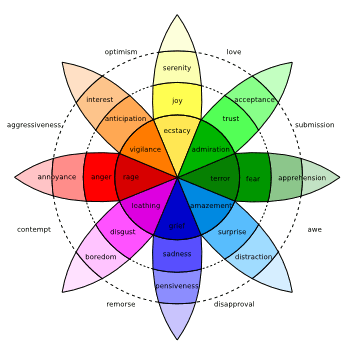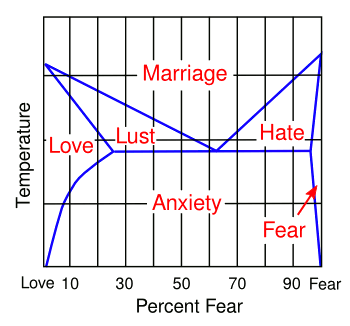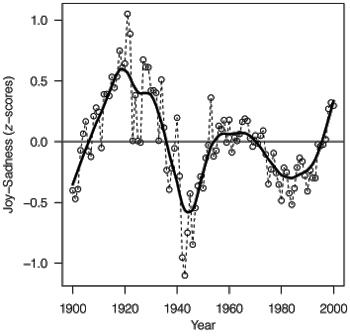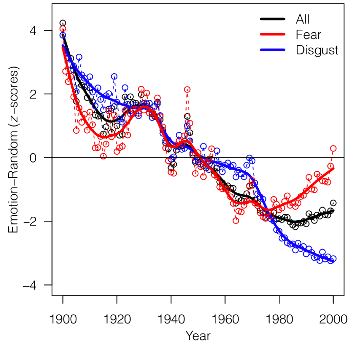Plotting Emotions
April 10, 2013
First a mild
disclaimer. I'm not a
psychologist, so I don't have an
academic background in
human emotions. I'm also mindful of the fact that,
physics envy notwithstanding, other
scientists don't like it when
physicists transgress into their fields. One the other hand, I have many decades of experience in the subject, having lived that long.
Wikipedia's page on emotions has a sidebar list with sixty-nine words describing emotions. These are
affection,
anger,
angst,
anguish,
annoyance,
anxiety,
apathy,
arousal,
awe,
boredom,
contempt,
contentment,
courage,
curiosity,
depression,
desire,
despair,
disappointment,
disgust,
distrust,
dread,
ecstasy,
embarrassment,
envy,
euphoria,
excitement,
fear,
frustration,
gratitude,
grief,
guilt,
happiness,
hatred,
hope,
horror,
hostility,
hurt,
hysteria,
indifference,
interest,
jealousy,
joy,
loathing,
loneliness,
love,
lust,
outrage,
panic,
passion,
pity,
pleasure,
pride,
rage,
regret,
remorse,
sadness,
satisfaction,
shame,
shock,
shyness,
sorrow,
suffering,
surprise,
terror,
trust,
wonder,
worry,
zeal and
zest. This list would likely serve as a good basis for some sort of tablet computer application.
Psychologist,
Robert Plutchik, organized human emotions into the chart shown below.
Plutchik's "wheel of emotions" is like a psychology version of the diagram for the
four classical elements (
Earth,
Air,
Fire and
Water).

Robert Plutchik's Wheel of Emotions
Eight basic emotions at the periphery are manifest in distinct emotions at the inner wheel portions.
Emotional intensity increases towards the center.
(Click for larger image.)
(Via Wikimedia Commons.)
In my opinion, two of these emotions can be called principal emotions, since they offer an
evolutionary advantage. These are fear, which works to preserve the individual; and love, which works to preserve the
species. Whenever a
materials scientist encounters two components, he immediately envisions a
phase diagram, a humorous version of which appears below.

A Fanciful Love-Fear Phase Diagram
An illustration of the concept of "mixed emotions."
(Rendered by the author using Inkscape.)
An international team of scientists from the
University of Bristol (Bristol, UK),
Stockholm University (Stockholm, Sweden), the
University of Sheffield (Sheffield, UK) and
Durham University (Durham, UK) has published an
open access article in
PLoS One in which they've gone beyond the usual
hand-waving speculation to create a quantified analysis of one facet of emotion.[1-4]
They examined the
frequency of usage of words having emotional content, what they call "mood" words, in
20th century English language books. They used the popular tool for such studies, the
Google Ngram Viewer, a
database of word frequency for millions of books. I wrote about the Ngram Viewer in a
previous article (Culturomics, January 13, 2011).
The study authors found evidence for historical periods of negative and positive mood; and, they found that, at least in books,
American English became more emotional than
British English in the latter half of the 20th century.[1] The study seems to provide evidence for the
British "
stiff upper lip."
The study traced words associated with joy, surprise, anger, sadness, fear, and disgust.[2,4] It was found that emotional words were used to a lesser extent as the 20th century progressed, except for fear, which has increased since the 1970s.[2,4] Happiness seems to be on the rise from the 1990s until 2008, the last year for which data are available.[3] There are
historical trends in the frequency of use of words with positive and negative emotional connotations, as shown in the figure.

We appear to be recovering from a major bout of sadness in the period 1970 to 1995.
A major period of sadness started pre-World War II, and it ended with the war. The "Roaring Twenties" appear to have lived up to their name.
(Fig. 1 of ref. 1, Creative Commons Attribution License.)[1)]
A separate analysis of a million American English and 230,000 British English books showed that
Americans, at least
American authors, were more emotional.[2-3] American emotionality has been increasing since the
1960s.[2,4] This might be a consequence of
economic conditions, since emotionalism might be a
luxury only accessible to those with sufficient resources. Says
Alex Bentley of Bristol University, a co-author of the study,
"We don't know exactly what happened in the Sixties but our results show that this is the precise moment in which literary American and British English started to diverge. We can only speculate whether this was connected, for example, to the baby-boom or to the rising of counterculture... In the USA, baby boomers grew up in the greatest period of economic prosperity of the century, whereas the British baby boomers grew up in a post-war recovery period so perhaps 'emotionalism' was a luxury of economic growth."[2]

Difference between word scores for the emotions of joy, surprise, anger, sadness, fear, disgust, and the equivalent scores of a random sample for the period 1900 to 2000.
Highlighted are the trends for fear and disgust.
(Fig. 2 of ref. 1, Creative Commons Attribution License)[1)]
The study authors express the usual caution that these trends in the written word may not directly mirror the emotional state of the populace.[2-3]
Teddy Wayne, in a recent article in
The New York Times, writes about how emotional words, such as obsession, have lost their edge, so they're being used more frequently. As Wayne writes,
" 'Awesome' used to mean 'inspiring awe' and now it means, 'That was a great burrito, dude.' " [5]
References:
- A. Acerbi, V. Lampos, P. Garnett and R.A. Bentley, "The Expression of Emotions in 20th Century Books," PLoS ONE, vol. 8, no. 3 (March 20, 2013), Document No. e59030.
- Expression of emotion in books declined during 20th century, study finds, University of Bristol Press Release. March 20, 2013.
- Philip Ball, "Text mining uncovers British reserve and US emotion," Nature News, March 21, 2013.
- Shaunacy Ferro, "American English Has Become Way More Emotional Than British English," Popular Science, March 22, 2013.
- Teddy Wayne, "Obsessed? You're Not Alone," The New York Times, March 22, 2013.
Permanent Link to this article
Linked Keywords: Disclaimer; psychologist; scholarly method; academic background; human; emotion; physics envy; scientist; physicist; affection; anger; angst; anguish; annoyance; anxiety; apathy; arousal; awe; boredom; contempt; contentment; courage; curiosity; depression; desire; despair; disappointment; disgust; distrust; dread; ecstasy; embarrassment; envy; euphoria; excitement; fear; frustration; gratitude; grief; guilt; happiness; hatred; hope; horror; hostility; hurt; hysteria; indifference; interest; jealousy; joy; loathing; loneliness; love; lust; outrage; panic; passion; pity; pleasure; pride; rage; regret; remorse; sadness; satisfaction; shame; shock; shyness; sorrow; suffering; surprise; terror; trust; wonder; worry; zeal; zest; Robert Plutchik; Plutchik's "wheel of emotions"; four classical elements; Earth; Air; Fire; Water; Wikimedia Commons; fitness; evolutionary advantage; species; materials science; materials scientist; phase diagram; Inkscape; University of Bristol (Bristol, UK); Stockholm University (Stockholm, Sweden); University of Sheffield (Sheffield, UK); Durham University (Durham, UK); open access; PLoS One; hand-waving; speculation; frequency; 20th century; English language; book; Google Ngram Viewer; database; American English; British English; British; stiff upper lip; history; historical; Roaring Twenties; Creative Commons Attribution License; Americans; American authors; 1960s; economic development; economic condition; luxury; Alex Bentley; Teddy Wayne; The New York Times.